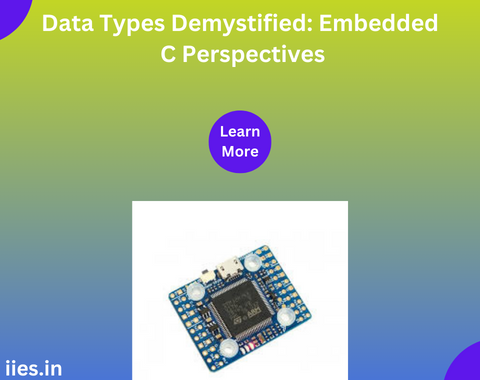
Embedded systems play a crucial role in our modern world, powering everything from smart home devices to complex industrial machinery. At the heart of these systems lies Embedded C programming, a specialized form of C language tailored for resource-constrained environments. Understanding data types in Embedded C is paramount for efficient and reliable software development. In this article, we’ll delve into the intricacies of data types in Embedded C, exploring their significance, usage, and optimization techniques.
– Embedded systems often operate within limited resources such as memory and processing power.
– Efficient data handling is critical for achieving optimal performance and resource utilization.
– Data types define the size, range, and behavior of variables, impacting memory usage and program execution.
Fundamental Data Types in Embedded C:
– Integer Types: char, int, short, long – their sizes and ranges vary depending on the architecture.
– Floating-Point Types: float, double – used for representing real numbers with fractional parts.
– Void Type: Represents absence of type, commonly used with pointers.
Custom Data Types:
– Structures: Group related data elements under a single name, facilitating organization and abstraction.
– Unions: Similar to structures but share the same memory location for all members, useful for memory optimization.
– Enums: Define named integral constants, improving code readability and maintainability.
Data Type Modifiers:
– Signed and Unsigned: Specify whether a variable can hold negative values (signed) or only non-negative values (unsigned).
– Const and Volatile: Const indicates that the variable’s value cannot be changed, while volatile informs the compiler that the variable’s value may change unexpectedly (e.g., by an external event).
Memory Considerations:
– Stack vs. Heap: Embedded systems often have limited stack and heap memory. Understanding data types helps in efficient allocation and management.
– Data Alignment: Proper alignment of data types can improve memory access efficiency, especially in architectures with alignment requirements.
Optimization Techniques:
– Bit Manipulation: Leveraging bitwise operations for compact data representation and efficient processing.
– Data Packing: Arranging data structures to minimize memory wastage, crucial in memory-constrained environments.
– Type Casting: Converting between data types judiciously to avoid loss of precision and ensure correct behavior.
Platform-specific Considerations:
– Endianness: Understanding byte order is essential for data exchange between different platforms.
– Compiler-specific Features: Compiler directives and options can influence data type sizes and behavior, necessitating awareness of compiler nuances.
Handling Data in Interrupt Service Routines (ISRs):
– ISRs often operate in a constrained environment with limited execution time.
– Careful selection and manipulation of data types within ISRs are crucial for meeting real-time requirements and avoiding race conditions.
Debugging and Testing:
– Data type mismatches and overflows can lead to subtle bugs and system failures.
– Rigorous testing, including static analysis and dynamic testing, helps in detecting and rectifying data-related issues early in the development cycle.
Power Consumption Considerations:
– In battery-powered embedded systems, minimizing data size and processing overhead directly translates to lower power consumption.
– Choosing appropriate data types and optimization techniques can contribute to extending battery life and enhancing energy efficiency.
Real-Time Operating Systems (RTOS) Integration:
– RTOSs impose additional constraints on data handling due to their scheduling and multitasking nature.
– Data types must be selected and managed carefully to ensure deterministic behavior and meet real-time deadlines.
Interfacing with Hardware:
– Embedded systems frequently interact with various peripherals and sensors, each with its own data format and communication protocol.
– Effective data type handling facilitates seamless communication between the embedded software and external hardware components.
Data Integrity and Security:
– Embedded systems deployed in critical applications, such as automotive or medical devices, require robust mechanisms for ensuring data integrity and security.
– Data types play a vital role in implementing encryption, authentication, and data integrity checks to protect sensitive information.
Cross-Platform Development:
– Embedded software often needs to be ported across different hardware architectures and platforms.
– Understanding data type portability and addressing endianess issues is essential for maintaining code compatibility and reliability across platforms.
Industry Standards and Best Practices:
– Various industry standards and guidelines, such as MISRA-C for automotive and DO-178C for avionics, provide recommendations for data type usage and handling.
– Adhering to these standards ensures code reliability, safety, and compliance with regulatory requirements.
Continuous Integration and Deployment (CI/CD) Pipelines:
– Integration of data type checks and static analysis tools into CI/CD pipelines helps in early detection of potential data-related issues.
– Automated testing and validation processes ensure that data types are used correctly and consistently throughout the software development lifecycle.
Future Trends and Challenges:
– With the proliferation of Internet of Things (IoT) devices and edge computing, embedded systems are becoming increasingly interconnected and complex.
– Data type management will continue to be a critical aspect of embedded software development, requiring adaptation to evolving hardware architectures and programming paradigms.
Training and Education Initiatives:
– Educational programs and training courses focusing on embedded systems programming should emphasize the importance of data types and provide hands-on experience with optimization techniques.
– Continuous learning and professional development opportunities empower embedded developers to stay abreast of advancements in data type handling and embedded software engineering practices.
Data types form the foundation of Embedded C programming, shaping the efficiency, reliability, and maintainability of embedded software. By understanding the nuances of data types and employing optimization techniques tailored for embedded systems, developers can craft robust and efficient software solutions for a wide range of embedded applications. Continuous learning and adaptation to evolving hardware and software technologies are key in mastering data types in the realm of embedded systems programming.
Indian Institute of Embedded Systems – IIES